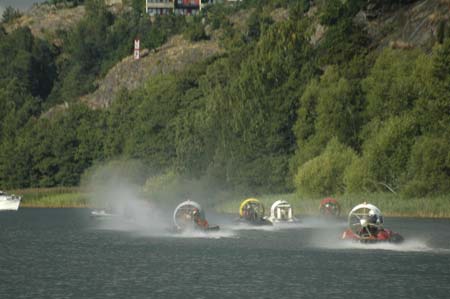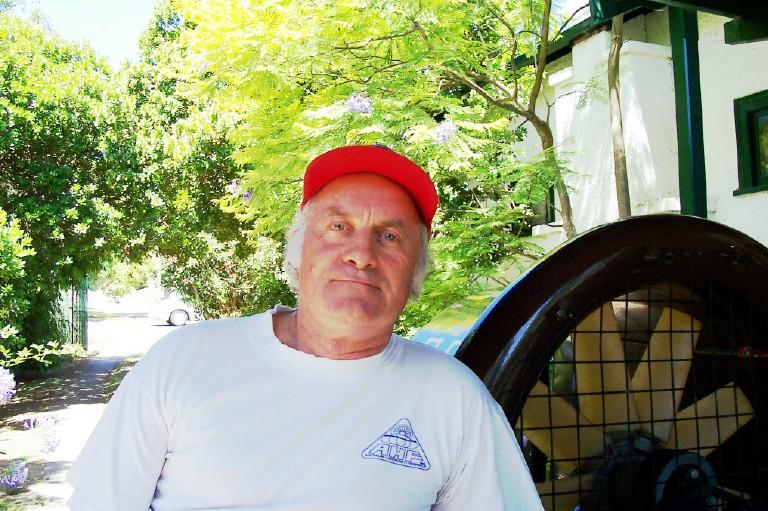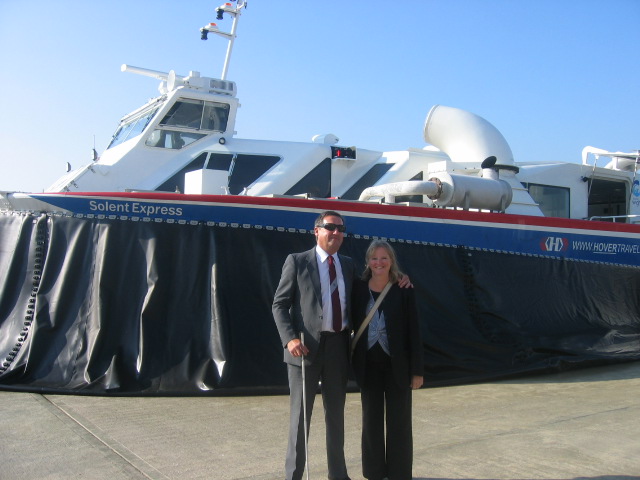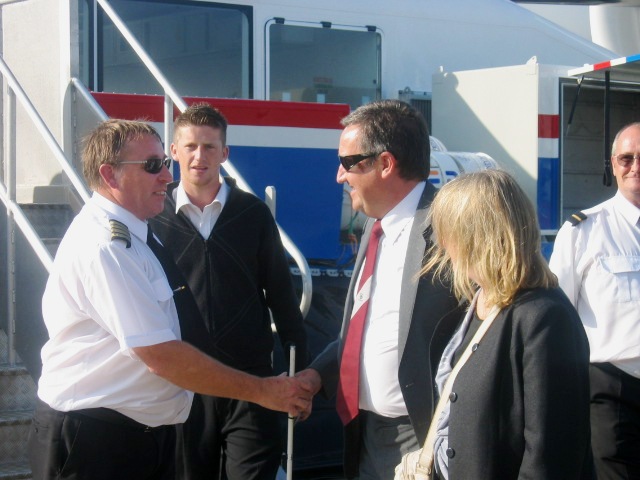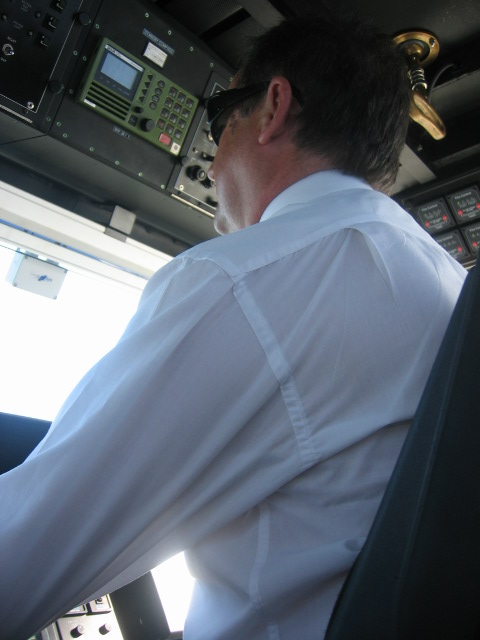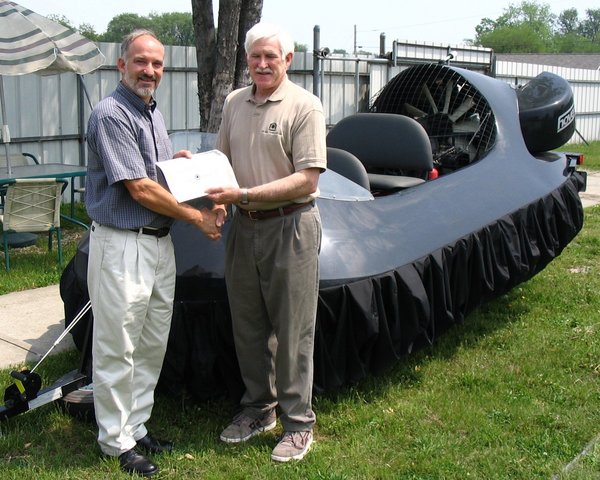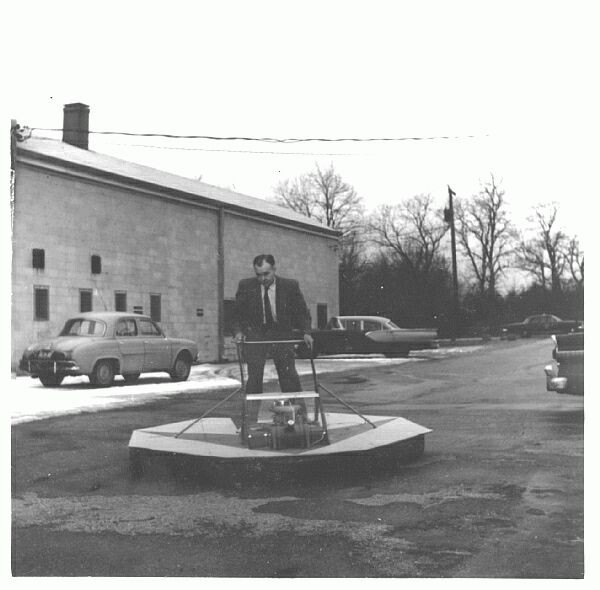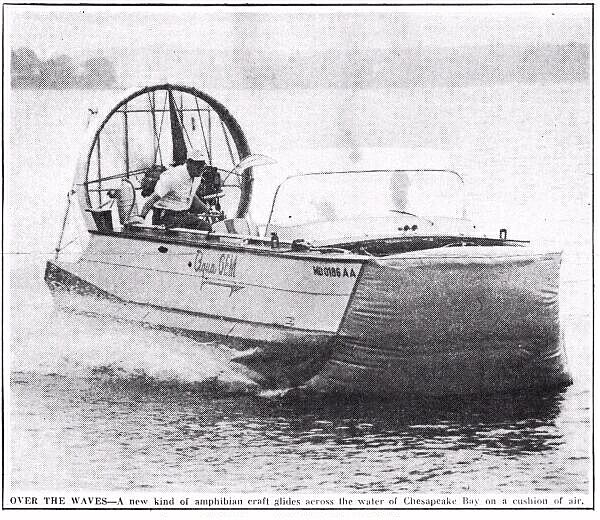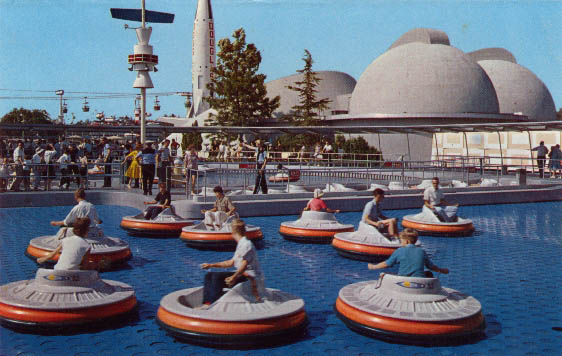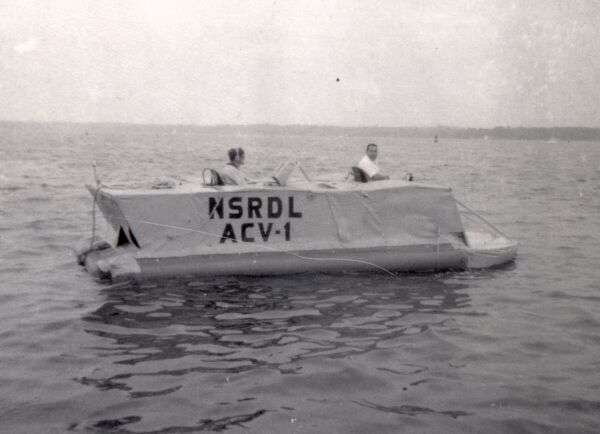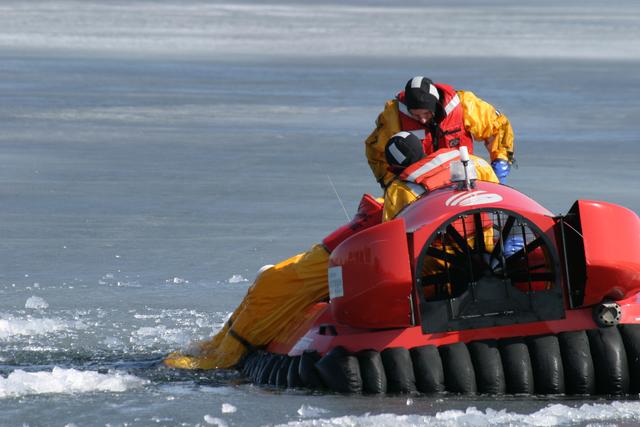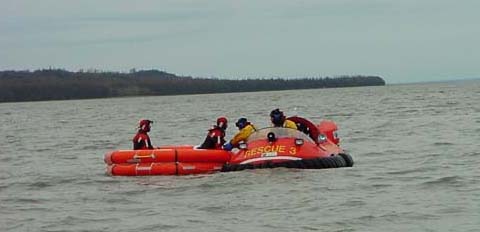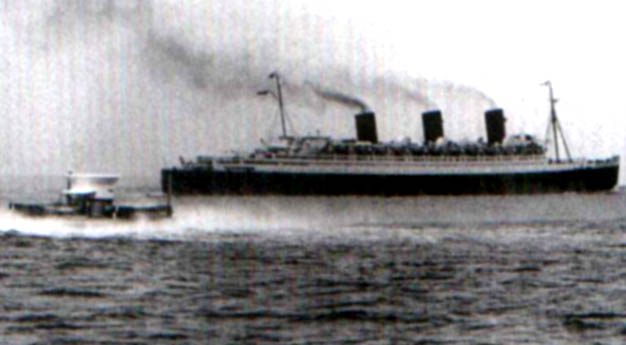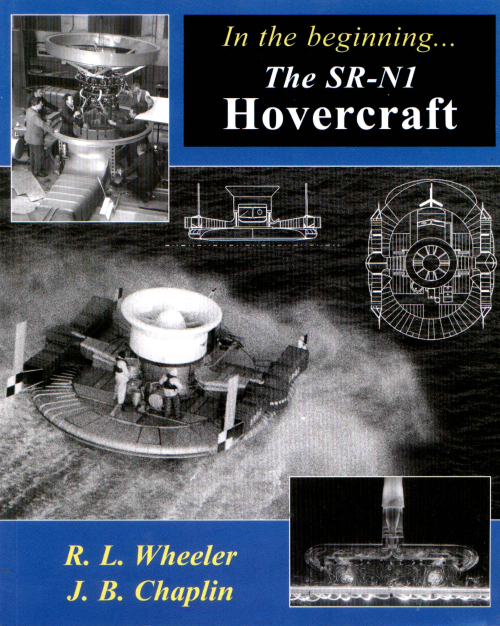|
In this issue: As a HoverWorld Insider reader, you’re in good company! You belong to an expanding global group of 20,000 hovercraft enthusiasts and industry professionals who are spreading the word about hovercraft. Although the HoverWorld Insider is a publication of the World Hovercraft Organization, it is produced and funded in entirety by Neoteric Hovercraft, Inc. In a recent interview, publisher Chris Fitzgerald, Neoteric’s President and founder of the World Hovercraft Organization, discusses the history, purpose and future of HoverWorld Insider … and the role you play in that future.
Chris, what made you decide to publish a newsletter for the World Hovercraft Organization? The newsletter began when I served as Chairman and organizer for the World Hovercraft Federation’s 2002 World Hovercraft Championship in Terre Haute, Indiana USA. Participants and attendees came from more than 20 nations so we needed an efficient way to keep everyone informed as plans developed. An email newsletter was the ideal way to do that, as well as to share the city-wide excitement and to encourage the undecided to pack their bags and join us. In that previous incarnation, the newsletter was known as the WHC Insider. We still have those early issues online at www.WHC2002.com; they’re interesting reading, even though they were devoted to a specific event. We were inundated with positive feedback about the WHC Insider; many people told us that they’d not planned to attend the World Championship until the newsletter enticed them to come. In response to this popular demand, we decided to continue the newsletter after the event, with expanded content and a new name: HoverWorld Insider. Who are your subscribers and how many readers do you have? We now have more than 11,000 subscribers, but other hovercraft manufacturers have asked to distribute it to their mailing lists, so I would estimate HoverWorld Insider readership to be more than 20,000. Our readers are a varied lot – hovercraft owners, manufacturers, military personnel, students - because the HoverWorld Insider isn’t aimed at particular segment of the population. It’s for anyone interested in hovercraft and air cushion vehicles. No one is more important to us than our readers because they determine the subject matter of the HoverWorld Insider. New subscribers complete a brief survey about their hovercraft interests and we’ve compiled their responses since the launch of HoverWorld Insider; this is what guides our editorial process. Do similar hovercraft newsletters exist? With the Internet there are many ways for likeminded people to connect. Hovercraft clubs offer newsletters, but I know of no single hovercraft publication that caters to such a variety of readers and pulls everyone together the way the HoverWorld Insider does. What do you hope to accomplish with the HoverWorld Insider? As I said, we want to pull everyone together and to serve as a central resource for anyone interested in hovercraft. The newsletter’s mission is to embrace, promote, and provide communication between the various niches of hovercraft industry – manufacturers, clubs and societies, rescue organizations and law enforcement, the military – as well as individual racers, cruisers, and enthusiasts. The end goal is to help overcome the lack of awareness of the practical and valuable uses of hovercraft. You’ve been involved with hovercraft all your life. Do you have a background in newsletter publishing? After collecting the broken pieces of the Hoverclub of America in its early days, 1975-76, I incorporated the club then later went on to edit and publish its newsletter, HoverNews. This took place during the growth years of the Hoverclub, 1980 to 1983. This was excellent experience and paved the way for our current endeavor. Why should the world know more about hovercraft? What is the most important aspect of hovercraft that you can convey to your readers? I think it’s important for anyone with an interest in hovercraft to understand what brought about their invention and how that has changed over the years. Air cushion vehicles were originally invented as a means of efficiently traveling fast over water, a way to use less energy to travel fast. I’m defining ‘fast over water’ as speeds above 30 mph, or 48kmh. However, the hovercraft’s amphibious abilities were soon proven to be more important than high speed capacity, and they’re now used to save lives in situations that prohibit the use of other rescue vehicles: ice, swiftwater, mud and so on. Hovercraft also offer lots of pleasure as recreational watercraft, and they’re very kind to the environment because they have a soft footprint pressure. Hovercraft are also an ideal educational tool, a terrific way to engage students. That’s what the World Hovercraft Organization’s DiscoverHover program is all about. The hovercraft isn’t like a bicycle; it’s much more complicated, with intricate technical challenges. Students are fascinated by hovercraft, and building their own involves them in so many different subject areas, from physics, math, and aerodynamics to electricity, painting and working together cooperatively. We also incorporate history into the DiscoverHover program, from the history of the hovercraft itself, to historical figures important in hovercraft theory, such as Archimedes, Bernoulli and Isaac Newton. Since the HoverWorld Insider was originally designed to promote specific events organized by Neoteric, do you foresee more events in the future? Yes! At present Neoteric is undergoing a rapid growth phase, so my time is limited. Once we complete our current reorganization, I plan to turn my attention to developing new hovercraft events. We hope to start with a DiscoverHover event that will include racing competitions and seminars for students. Hovercraft have been around for about 50 years; why are they still largely unknown? A major reason is that the hovercraft industry is still relatively small. At any one time, there are probably no more than ten hovercraft manufacturers in the world. Several of those are small operations, which come and go with great rapidity; there are only four or five hovercraft manufacturing concerns with a stable, significant history. Another factor is that most of us in the industry are technical people, not promotional people. I was fortunate in that respect because I grew up listening to a father who operated his own business, a sheet metal company, so our dinner table conversation revolved around business and marketing – how to advertise, attract customers, balance books and so on. I suppose the old adage ‘like father, like son’ comes into play and interests me in projects like the HoverWorld Insider. How many hours does it take to produce an issue of HoverWorld Insider and what costs are being absorbed by Neoteric? Information gathering and writing takes on average more than 100 man hours per issue; fact-checking, proofreading, editing, email distribution, and survey and feedback compilation adds at least another 50 man hours. If I include not only salaries, materials such as paper and Internet fees, but also overhead – rent, utilities, taxes and so on – we’re absorbing close to 10,000 US dollars per issue. That’s significant. Put it into perspective: what else could Neoteric do with 10,000 US dollars, and why are you willing to absorb such costs? Let’s see … we could buy a new urethane foaming machine for the factory, or four TIG welding machines, or one to four hovercraft engines, depending on their size. Or we could place a quarter-page ad in Popular Mechanics, which would probably sell two or three hovercraft. As to why Neoteric is putting that money instead into the HoverWorld Insider, well, it’s just our contribution to the industry. When the industry expands, everyone involved can benefit. So, ironically, the HoverWorld Insider is likely to boost not only Neoteric’s success but that of your competitors as well. When can you say “mission accomplished”? I want us all to be successful, but success is difficult to judge. Every time a reader lets us know they’ve found some value in an issue; every time a school incorporates a hovercraft project into their curriculum; every time a life is saved by any manufacturer’s rescue hovercraft - these are the things that make it worthwhile for me and are good indicators of industry success. But you have to understand that this is a long term project. A final “mission accomplished” probably won’t be appropriate until long after I’m gone. But, don’t worry, I’ll be looking down … or maybe up!
World Hovercraft Championship 2008 – August 2008 The World Hovercraft Federation (WHF) has announced the location and dates of the 2008 World Hovercraft Championship. Though Norway had to withdraw its preliminary hosting bid, Sweden stepped up and offered an application. In November this application was reviewed by the WHF and accepted, finalizing the location for the Championship.
The event is currently scheduled for 20th - 24th August, 2008 in Flottsbro, Sweden. This venue will be familiar to some, since both the 2005 and 2007 European Hovercraft Championship were held at the same location. According to the WHF, the races confirmed for the 2008 Championship will not include endurance racing because Sweden’s official permit does not allow enough time for an endurance event. The WHF has proposed a separate World Championship Endurance Race. Any country interested in hosting the Endurance Championship is encouraged to email Christel Martens, WHF secretary. Events which will take place during the Championship include: Formula 1, Formula 2, Formula 50, Formula S, and Formula J. If enough drivers express an interest, Formula 3 racing will also take place. By the end of January, the WHF hopes to have the registration details and dates finalized. Fees are predicted to be approximately 50 – 80 Euros per hovercraft, though these are subject to change. Final registration details and fees will be posted soon on the World Hovercraft Federation website. For more information on accommodations and sponsorship of the Hoverclub of Sweden, visit the World Hovercraft Federation. Hovering Along: A look behind the development and popularity of the Australian Schools Hovercraft Program With science programs designed for school participation, such as DiscoverHover, obtaining funding and support is the most difficult part of the program. Ken Osmond, an early adopter of the DiscoverHover curriculum and past President of the Australian Hovercraft Federation, recently retired from his post with the Australian Schools Program. His success in bringing hovercraft programs to schools in Australia, especially in the state of Victoria, is inspiring to other school programs trying to gain awareness.
Educational interest in a hovercraft program first began following hovercraft presentations by Osmond in schools. Excitement shown by students for building a hovercraft inspired Osmond and his fellow members of the Hovercraft Club of Victoria to develop a set of plans for interested schools. The hope was that building a hovercraft could be more accessible to everyone. As the Hovercraft Club of Victoria finalized plans for an entry level craft, school participation became easier. Instructions, plans, drawings and a CAD program allowed these schools to integrate the construction of a hovercraft into their science programs with minimal work. Beyond building a hovercraft, the Australians moved to keep students very active. The establishment of a skills test for students with their completed hovercraft has kept the enthusiasm of students high, as they compete against other students and display their craft and their piloting skills to those in the hovercraft community. After Melbourne’s Billanook College successfully built one of the Club’s plans, the program was on its way to gaining widespread approval. The operation was such an overall success that Osmond was invited to speak about the program at the Victorian Teacher’s Science Conference. A video demonstration provided by Billanook depicting their craft and building experience allowed Osmond to illustrate the benefits and excitement generated by the program. He found that this conference generated an increased interest in the important role hovercraft can play in education. With the help of Chris Fitzgerald in the United States, the Australian program was expanded and formalized to create the DiscoverHover program known today. Osmond took the plans finalized for DiscoverHover and began speaking at more science conferences. This brought more and more Australian schools into the program. Osmond states, “We have in my home state of Victoria 20 schools taking part in the program; some of these have now built five hovercraft.” Conferences and demonstration have formed the basis of developing a following for the Australian Schools Hovercraft Program. In addition to learning the science involved with the craft, students also gain experience in securing sponsorship and support for their project. “This involves students going out into the community and talking to prospective sponsors and planning their own promotions and fund raising efforts,” Osmond explains.
In Australia, funding for DiscoverHover works a little differently than anywhere else. While the schools are still responsible for many expenses relating to the cost of craft production and cost of student involvement, the Hovercraft Club of Victoria itself has received a 3,000 US dollar grant from the Victorian Communities Grants Unit. This grant was available to the Club due to the volunteer efforts of students and parents. The Club is mainly using the money to assist in covering costs associated with postage, traveling expenses, discs for plans, and printing. The grant will also finance a new hovercraft which will be used for school demonstrations as well as for teaching piloting skills and further inspiring interest in the program.
Receipt of a grant has been beneficial to the expansion of the program. Members of the Hovercraft Club of Victoria, such as Steve Lanyon, have used grant money for trips to Queensland and Tasmania to broaden the reach of the program at the insistence of the State Education Program. The Australian Schools Hovercraft Program is notable not only for its receipt of funding, but also in that its main publicity comes from within supporting schools. Through holding promotions in schools, having teachers give testimony about the project at conferences, or simply spreading the word of DiscoverHover’s accomplishments, Australian schools have taken a large share of the running of the program onto their shoulders. The future of DiscoverHover in Australia seems bright to Osmond. “Although the program is only running in my State of Victoria, the new year will see many interstate schools joining in 2008.” The vibrant enthusiasm of involved schools and strong support from the Hovercraft Club of Victoria, promises a bright future for the Australian Schools Hovercraft Program. For more information, or to volunteer, visit the Hovercraft Club of Victoria website. Blind Man takes control of Solent Express Colin McArthur lost his sight 20 years ago, yet this year he piloted Hovertravel’s Solent Express between Ryde and the Isle of Wight to gain awareness for Retinitis Pigmentosa. The Solent Express is Hovertravel’s newest addition to their fleet of hovercraft ferries that navigate one of the world’s busiest shipping lanes.
The opportunity to slide behind the controls of the Solent Express came solely by accident for McArthur. As fundraising managers of the British Retinitis Pigmentosa Society, both McArthur and his wife Linda have previously arranged a fundraising event on the Isle of Wight. For this year’s event, the two offhandedly asked for permission to offer hovercraft trips to raise money. While Hovertravel had to turn down the couple’s request, they were surprisingly unfazed by McArthur’s returning request to pilot the craft himself. “I can’t see why not,” came the response from Hovertravel Operations Manager Captain Barrie Jehan. The Solent Express, a 130-seat passenger hovercraft, was first launched in June 2007. Designed and built by Hoverwork, Ltd, a sister company of Hovertravel, the Solent Express is capable of 45 knots. It is much quieter than previous designs due to its water-cooled turbo-diesel lift and propulsion engines. The Express also uses variable pitch propellers. Weighing 70 tons, the large craft is designed for easier navigation through adverse conditions as well as for more passenger space.
“I have never piloted a hovercraft before, but the craft was so smooth, gliding across the water and the controls were easily managed,” states McArthur. He took control from the Solent’s usual pilot, Captain Graham Snow, and proceeded to steer the hovercraft for 20 minutes, navigating from Ryde around Fort Solent and then back towards Ryde. Captain Snow piloted the craft during its entrance and exit from the hoverport.
As backup pilot for McArthur, Captain Snow indicated which control rudders to move and in which direction to shift the bow thrusts. “The weather conditions were ideal,” states McArthur. “It was flat-calm with little or no wind, but Captain Snow informed me that the real skill comes in controlling the craft when the seas are rough and strong winds are blowing you off course.” McArthur’s blindness is caused by Retinitis Pigmentosa (RP), the disease for which he raises awareness. Blindness from RP results from defective genes turning off the cells in the retina. Through testing and treatment trials, scientists are exploring the possibility of replacing defective cells with stem cells. While this could help restore sight to those with RP, “the costs of treatment trials are huge,” explains McArthur, “therefore it is important to bring to the attention of the public the need to raise funds and awareness.” Piloting the Solent Express raised a large amount of publicity for RP. McArthur says, “We were contacted by radio stations in Northern Ireland, Scotland and England, also several newspapers and TV companies.” What was the result of so much attention? The British Retinitis Pigmentosa Society received 3,000 Euros in donations. Still, with the high costs of treatment trials, the Society is always in need of further donations. Of his experience with the Solent Express McArthur exclaims, “Yes I would do it again if asked.” For more information on the event or to donate, please visit the British Retinitis Pigmentosa Society. Visit YouTube to see videos of the Solent Express in action. Hover STAR Network: A new hovercraft safety and accident reporting website For members of the hovercraft community, a new website offers a place to find and report safety issues as well as possibly help insurance companies better evaluate the hovercraft.
HoverSTARnet.com, founded by Bob Rossier of Wild Winds Hover Tours, is a site devoted to safe operation of hovercraft. With his site, Rossier hopes to improve the practices of hovercraft operators, while serving as a database for accidents and other safety-related information.
Rossier gained experience in safety and training as a pilot, flight instructor and scuba diving instructor. His writings for the aviation and scuba communities often addressed safety issues. As a hovercraft owner and founder of Wild Winds Hover Tours, he is conscious of the specific difficulties in handling a hovercraft. Rossier originally developed his idea after discovering there was no forum where hovercraft operators could discuss their experiences. He wanted to create a place other than a rally where operators could gather to discuss important issues, similar to pilots chatting at an airport. What Rossier hopes these operator discussions will lead to is an increased awareness of information and resources dealing with hovercraft. By exchanging ideas, operators can come in contact with better training and become aware of important safety issues. Rossier believes that continuing education for operators will result in fewer mistakes and accidents with hovercraft. Eventually, Rossier would like to see Hover STAR Network provide enough information to allow insurance companies to properly evaluate the hovercraft. Rossier explains, “There is not a large body of accident data available on which insurance companies can base their rates.” With the information hovercraft users submit on his site, Rossier hopes insurance companies will have a better foundation on which to develop their rates. Hover STAR Network is still relatively new, so Rossier is working diligently to establish the network in the hovercraft community. He explains, “The hovercraft community as a whole has much to gain through the Hover STAR Network, and I’m hoping that by working together, we can all make a difference.” Learn more about hovercraft safety by visiting The Hover STAR Network. Melville Beardsley: A pioneer’s impact on hovercraft development With several patents in the field of air cushion vehicles and a long history of early hovercraft production, Melville Beardsley, 1913-1998, will be long remembered as a valuable pioneer in the hovercraft industry.
From family testimony, Beardsley was long known as an avid lover of flight. After a childhood of long days building model planes and tinkering with other mechanical devices, he entered the University of Illinois in 1935 for a degree in mechanical engineering. Soon after receiving his degree, Beardsley entered the US Army Air Corps where he became a pilot. In the army, Beardsley achieved the rank of Colonel while also receiving postgraduate degrees in thermodynamics and combustion engines from both Georgia Tech and the University of Chicago. He was also exposed to many opportunities to hone his engineering skills and display his ingenuity as he worked on various military projects. After his 1946 discharge, Beardsley’s army connections led him to a position as aerodynamics engineer for Northrup Aircraft in California, where he worked on a long range bomber prototype aptly called the ‘Flying Wing.’ Known today as the Snark, the Flying Wing had no fuselage or tail, giving it the appearance of an aircraft wing in flight. Beardsley stayed with Northrup long enough to pilot his prototype and then moved on.
During the next few years Beardsley worked to perfect the vacuum cooling process for lettuce in California’s Salinas Valley. Shortly after this project, the Korean War again pulled him into active duty for the Air Corps, though he never left the USA. It was after his permanent move into the US Army Air Corps reserves that Beardsley joined with a fellow officer, William H. Alper, to establish National Research Associates, Inc. (NRA), and began serious work with air cushion vehicles. As Vice President of NRA, Beardsley supervised the design, construction and testing of various air cushion vehicles. Beardsley’s prototype, the 28ft long Aqua GEM, was produced in 1961. Demonstrations of the craft were given mainly to the Maritime Administration, the Marine Corps and the Office of Naval Research, but the hovercraft’s appeal to civilians was immediately apparent.
Looking much like today’s single-operator hovercraft, the Aqua GEM was powered by a 50hp water-cooled engine located in the rear of the craft, near the propeller mounted at the stern. Twin 20hp engines supplied lift power to the fans in the bow of the craft. With five rudders to help guide it, and the air cushion effect engaged, the craft was capable of 40 mph. The Aqua GEM could also move through the water without an air cushion, propelled awkwardly forward through the sole use of the aft fans. With a total payload of 1,500 lbs, Beardsley’s hovercraft attracted several buyers in the industrial sphere. By 1962, Beardsley’s hovercraft had spawned three separate models, the Air Liner, the Air Carrier and the Air-Sport. The horsepower required for each craft’s engines had been drastically upped since the release of the original Aqua GEM. Each craft had twin 40hp engines to power their air cushions and a single 80hp two-cycle rear engine for fan power. These new hovercraft were designed with practical use in mind, and each had special properties. The Air Liner, a commuter hovercraft, was designed to carry up to 10 people in its fully enclosed and soundproof passenger space. The Air Carrier was more of a freight craft, with a cargo space of 8x12 ft. With a hardtop roof similar to that of the Air Liner, the Air Carrier provided a greater level of comfort to its two man crew. The far more luxurious Air Sport was designed to appeal to the yachtsman. The interior of the Air Sport contained a galley complete with a stove and sink, as well as beds for up to four people. Each craft was close to 30ft long and could reach 40mph. When opened to public trade in 1960, National Research Associates, Inc. had received nearly 60,000 US dollars in investments. The company had also sold licenses to Disney for the production of a Disneyland amusement ride called “The Flying Saucer.”
Beardsley’s business seemed to be thriving, but problems lay ahead. Naval contracts never appeared for NRA, even though they were vigorously sought. The company was quickly running out of money and was driven out of business by 1963 through the lack of sales. Although he had owned a patent for the peripheral jet from 1954, Beardsley found himself embroiled in an interference action to establish whether he or Christopher Cockerell was the first to invent the hovercraft principle. As history shows, Beardsley lost his claim on the patent to Cockerell. The reasoning is unclear but Beardsley’s son, John Beardsley, claims the lawyer withheld proof of Beardsley’s patent payment. Whatever the cause, Cockerell ended up paying 70,000 US dollars to Beardsley to settle the dispute and gain rights to the patent in doubt as well as another patent describing the use of skirts. By 1967, Beardsley had been unsuccessful in starting his own company and he found himself again working for the US Military. In the Naval Ship Research and Development Laboratory, his work with air cushion vehicles likely aided in the development of the amphibious military craft of today. Beardsley’s retirement from the Lab in the late 1970’s did not stop his inventive mind. He continued to work on many projects, including a system of beach erosion prevention, until his death on November 26, 1998. A more detailed biography by Beardsley’s son is available on his website Melville Whitnel Beardsley. Homeland Security Grant provides rescue hovercraft to Indianapolis, Indiana "Hovercraft, to me, are the greatest potential device that I can possibly think of for rescue work … It's about the price of a good motorcycle, and that's nothing if you can use it to save just one life," states former director Dick Setliff about the rescue hovercraft employed for the last seventeen years by the Vigo County Emergency Management Agency in Terre Haute, Indiana. Their hovercraft was purchased in 1991 with private funding provided by philanthropist Mari Hulman and donations from local businesses. Even though a public agency’s acquisition of anything new often raises political questions, particularly so when the value of rescue hovercraft isn’t widely known, the Vigo Country purchase was eagerly embraced by both the public and private sector. But Terre Haute had an advantage: as the home of Neoteric Hovercraft, Inc. since 1975, hovercraft were a familiar sight and Neoteric craft had often been employed in rescue operations beyond the capabilities of other rescue vehicles. The Indianapolis, Indiana Fire Department did not have that advantage when they recently purchased a Neoteric six-passenger rescue hovercraft. In the post 9/11 world, rescue hovercraft acquisitions may raise even further questions because federal funding may be involved. The Department’s hovercraft was paid for by a grant from the US Department of Homeland Security.
The Indianapolis Fire Department performs about 150 water rescues in Marion County and Central Indiana each year and recognized that a hovercraft would expand their capabilities far beyond the scope of ordinary rescue equipment. Debbie Fletcher, spokeswoman for Marion County Emergency Management, states the hovercraft will fill the current gap in effective swiftwater and ice rescue. She cited a 2003 case where a woman died after her car was trapped in floodwaters when rescue workers couldn’t reach her because the current was too fast. Initial concern was raised by Indiana Senator Thomas J. Wyss over whether the purpose of the hovercraft satisfies Homeland Security grant requirements. “Homeland Security money is not just for taking care of your, quote, everyday needs that you have for public safety,” explained Wyss. He stated that the main purpose of the grant is to protect against terrorism. Since Wyss chairs the committee responsible for regulating Homeland Security spending, his opinion carries particular weight. Indianapolis Fire Chief Jim Greeson was quick to dismiss any opposition in regards to the use of the hovercraft, explaining how it provided the unique and much-needed capability to rescue those in trouble on ice or water. Supporters of the hovercraft affirm that the grant will be used in a manner suitable for the overall protection of citizens. Homeland Security defines typical uses of the grant as varying from protection against terrorist attacks to disaster prevention and awareness. The acquisition of new rescue equipment often meets these stipulations and, as a rescue vehicle, a hovercraft clearly meets these grant qualifications. The Indianapolis Fire Department’s hovercraft was eventually recognized as a wise and prudent addition to their rescue fleet, and the initial uncertainty generated extensive positive interest in the hovercraft as a rescue vehicle. Newscasts by local Indianapolis television stations, including CBS affiliate WISH, NBC affiliate WTHR, and Fox affiliate WXIN aired several features, and articles published in the Indianapolis Star were picked up by the Associated Press and widely distributed. The news coverage highlighted the valuable role of hovercraft in rescue efforts as well as their innovative approach to the rescue situation. The information provided to viewers held a positive message, one of saving lives and property. In addition to capturing the interest of viewers and readers, the hovercraft drew the attention of media personalities as well. After visiting Neoteric for a demonstration ride, prominent WISH-TV news anchor was compelled to write about the craft in his featured blog. Impressed with the craft, Halvorson explained “it’s that amphibious quality that makes the craft so appealing to rescuers” said his onboard experience gave him “another reason to enjoy my job.” Indianapolis is not the first city to have problems initially gaining a positive response to a hovercraft purchase. Neoteric President Chris Fitzgerald remembers facing difficulties while trying to sell to a similar rescue department in Indiana, when a councilman would vote to approve the purchase only if the hovercraft had an American made engine. As Fitzgerald points out, “No one puts these sorts of stipulations on a fire truck or helicopter.” The councilman was outvoted and the hovercraft was put into service. To read the news coverage of the Indianapolis Fire Department hovercraft, see Neoteric Hovercraft in the News. Sergeant Bill Weiss of the Anchorage International Airport Police-Fire-EMS has spent many years of his long career advocating the use of hovercraft in rescue situations. His work has brought the hovercraft to Anchorage, Alaska and demonstrated its many uses in the rescue sphere. Beginning his career with Anchorage Airport Police and Fire in 1988, Weiss has long been acquainted with many of the risks involved with rescue operations, especially those involving ice. The airport shares a border with Cook Inlet and contains both Lake Hood and Lake Spenard within its boundaries, so the risks of unrecoverable crashes into icy water are high.
“We had no water rescue capability,” Weiss states about the time before the company purchased a hovercraft. A fatal crash into Cook Inlet revealed that water rescue can be as difficult as ice rescue. “The local fire department’s boat was unable to get to the crash scene due to low tide.” Weiss explains that there are often risks associated with the costal areas around Anchorage. “Community-wide, there have been deaths on the Cook Inlet mud flats and in ice-covered area lakes.” With these dangers such a heavy concern for the police and fire departments of Anchorage, a rescue solution had to be found. Through internet investigation and discussions with other departments with similar concerns, Weiss stumbled upon the hovercraft. Not widely used in Alaska, hovercraft were not initially an obvious answer. In the hovercraft, Weiss discovered a vehicle able to transverse all types of troublesome terrain. “We fly over and around sea ice and don’t have to worry about exposed sand bars at low tide. No one type of craft is the answer to all situations, but the hovercraft fills a very large gap in our community-wide rescue capabilities.” Anchorage Airport’s hovercraft quickly created an important niche for itself in the rescue community. Its rapid deployment and flexible abilities have made it an indispensable part of the airport’s rescue department. The original craft proved so useful that the department ended up purchasing another.
Weiss was invited to present his knowledge of rescue hovercraft at the International Symposium on Air Cushion Technology during World Hovercraft Week 2002, where he detailed the services provided by his department’s hovercraft and explained many of his rescue procedures. Weiss’ last few weeks with his department have included training days with many new crew members. A seasoned expert in hovercraft rescue operations, Weiss will leave behind a legacy of many hovercraft rescues as well as several well trained hovercraft crew members. This dedication to continuing the rescue hovercraft tradition is one great reason the hovercraft has remained valuable to the department. Without his inspiring work, Anchorage would not have such an innovative resource at its disposal. To read news coverage of Anchorage International Airport’s hovercraft rescue operations, with commentary by Sergeant Bill Weiss, see Hovercraft Mud/Ice/Water Rescue and Comments from First Responders.
In the Beginning: A new book on the SR-N1
For those interested in early hovercraft development, John Chaplin and Ray Wheeler have recently published a new book detailing the story of the SR-N1’s development and crossing of the English Channel. In the Beginning contains many insights into the technical development of the early hovercraft, including drawings and specifications throughout. The descriptions of the early models and the experimental tests done to complete the final craft are explained in full detail by the authors, who were deeply involved in the entire process. Perhaps the most interesting part of the book, beyond the tracing of the technical advancements, comes from reading the personal stories and historical perspective of the hovercraft development. Chaplin explains that he and Wheeler “agreed that we were both in a unique position to co-author the book.”
Chaplin met Christopher Cockerell in 1957 during his work as the Chief of Aerodynamic Research with Saunders Roe Limited running wind tunnel tests on the SR-53. Through this meeting, Chaplin was introduced to Wheeler, Deputy Chief of the Stress Office. Both were eventually recruited to work on the SR-N1 project. As Chaplin explains, the original plans for the SR-N1 called for the hovercraft to be remotely operated, but the size of the model craft was proven to be large enough for a small manned crew, so the plans were changed. Chaplin became a member of the SR-N1 crew near the end of the process, due to a recommendation based on his extensive knowledge of the hovercraft’s workings.
With such an intimate history of the craft, Chaplin outlines three main reasons for writing the book. He and Wheeler wished to detail the achievements of the entire team, which is often discounted in many writings describing Cockerell’s work. The two also feel that today’s technological increases have reduced the impact of the SR-N1 on the history of transportation. Finally, Chaplin and Wheeler feel that many of the descriptions of the original English Channel crossing portray the trip as “a piece of cake.” Chaplin remains adamant that this was not the case. He continues to explain many of the dangers of the trip. “During the first part of the crossing in the dark, I had to do this [operate the fuel system on the slippery deck] on my own with the deck pitching and rolling and without the safety back up of Bob [find out why Bob missed the flight by reading the book]. If I had slipped and fell overboard neither Sheepy at the controls, nor Cockerell on the bow and not looking, would have known.” Such a personal feel makes Chaplin and Wheeler’s book a wonderful addition to any hovercraft enthusiast’s library. It is available for individual purchase from the UK Hovercraft Museum for 13 Euros plus postage. To purchase wholesale boxes, email Peter Cross at Cross Publishing. Hovertechnics, Inc Hugh Firminger, co-founder of Hovertechnics, Inc., died October 1st, 2007. The hovercraft marketer retired from his business in 2006. Without Firminger, Hovertechnics has continued his tradition of success. Look for a more thorough biography of Firminger in an upcoming HoverWorld Insider feature story. Attention Hovercraft Manufacturers: To have your company news published in HoverWorld Insider, simply email it to Insider@worldhovercraft.org. …………………………………………………………………………………………………………………………… Subscribe to HoverWorld Insider HoverWorld Insider is published by the
World Hovercraft Organization. All rights reserved. |

